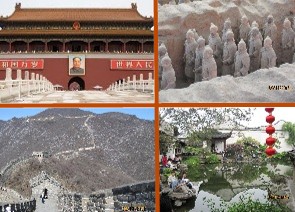Amazing China
 My wife and I recently vacationed in China and it was an exhilarating experience. Prior to this first foray to what 1.3 billion Chinese call “The Middle Kingdom,” I could have cited my knowledge of China’s history in two short paragraphs. This international trip, more than any before it, was as much an excursion in history as a sight-seeing adventure.
My wife and I recently vacationed in China and it was an exhilarating experience. Prior to this first foray to what 1.3 billion Chinese call “The Middle Kingdom,” I could have cited my knowledge of China’s history in two short paragraphs. This international trip, more than any before it, was as much an excursion in history as a sight-seeing adventure.
Spending 15 days, we landed in Beijing, moved on to Xian, Guilin, Suzhou and ended in Shanghai. Each city offered once-in-a-lifetime sights and riveting lessons in Chinese history and culture.
In Beijing, we walked along the world’s largest public square, Tiananmen Square, which is unfortunately best known for the government’s massacre of student protesters in 1989. To this day, most Chinese are unaware of the true extent of this tragedy because the government blocks all web sites detailing the event. Directly across from Tiananmen Square is the entrance to the Forbidden City, home of 24 emperors from 1421 until the last emperor reined in 1911. Entrance was denied to ordinary mortals for 500 years but now it’s a tourist site. Upon its entrance gate is a 20’ x 15’ color picture of Mao, who proclaimed the People’s Republic in 1949 at this very location. The walled Forbidden City is massive – 10,000 buildings covering 250 acres.
Words cannot describe the feeling of ascending to and walking along the 4,000 mile-long Great Wall of China – the world’s only man-made structure that can be seen from outer space. Begun in the 5th century BC, the wall is built on mountain tops; its walkways are an endless series of inclines and descents.
Around 220 BC, the first Chinese emperor to unite all of China built a massive tomb for himself. Constructed over 40 years by 700,000 workers, it contained nearly 8,000 life-size terracotta warriors that were entombed with the emperor. Located in central China near Xian, no one knew this tomb existed until local farmers chanced upon it in 1974.
Next up was Guilin and a river cruise along stunning limestone peaks. Formed 200 million years ago and rising nearly vertically, these breathtaking peaks hardly seem real.
Continuing on, we visited Suzchou, the “Venice of China” with its meandering canals. An hour from Shanghai, this city hosts several classical Chinese gardens. We also toured a Silk factory. Did you know that one silkworm creates 1,200 meters of thread?
Last on the itinerary was Shanghai. Few people know that from the Opium Wars in the 1840s until the end of WW2, Shanghai was governed by England, France, America and other countries – not China! The city is dissected by a river: On one side are dozens of gigantic skyscrapers, all built in the last 10-20 years. On the other side is the most famous sight in Shanghai – The Bund, a magnificent waterfront boulevard, lined with stately pre-1949 buildings with classical columns. We finished our tour in the beautiful Yu Gardens.
3 Comments
Get our expertise delivered to your inbox.
Sounds like a great tour Marc.
Can I ask which tour group did you go through?
We used Stanford University tours. You don’t need to be an alumni, but if you’re not, you pay $200 extra.
Standford University. You don’t need to be an alum to qualify.